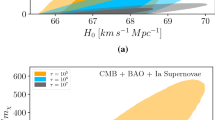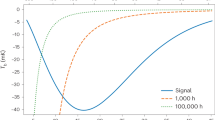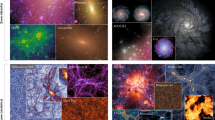Abstract
Cosmology is undergoing a revolution. With recent precise measurements of the cosmic microwave background radiation, large galaxy redshift surveys, better measurements of the expansion rate of the Universe and a host of other astrophysical observations, there is now a standard, highly constrained cosmological model. It is not a cosmology that was predicted. Unidentified dark particles dominate the matter content of our Universe, and mysteries surround the processes responsible for the accelerated expansion at its earliest moments (inflation?) and for its recent acceleration (dark energy?). New measurements must address the fundamental questions: what happened at the birth of the Universe, and what is its ultimate fate?
This is a preview of subscription content, access via your institution
Access options
Subscribe to this journal
Receive 51 print issues and online access
$199.00 per year
only $3.90 per issue
Buy this article
- Purchase on Springer Link
- Instant access to full article PDF
Prices may be subject to local taxes which are calculated during checkout




Similar content being viewed by others
References
Spergel, D. N. et al. First-year Wilkinson Microwave Anisotropy Probe (WMAP) observations: Determination of cosmological parameters. Astrophys. J. Suppl. Ser. 148, 175–194 (2003).
Ostriker, J. P. & Steinhardt, P. J. New light on dark matter. Science 300, 1909–1913 (2003).
Gaitskell, R. J. Direct detection of dark matter. Annu. Rev. Nucl. Part. Sci. 54, 315–359 (2004).
Bertone, G., Hooper, D. & Silk, J. Particle dark matter: evidence, candidates and constraints. Phys. Rep. 405, 279–390 (2005).
Ellis, J., Ferstl, A. & Olive, K. A. Theoretical aspects of dark matter detection. Space Sci. Rev. 100, 235–246 (2002).
Ellis, J., Olive, K. A., Santoso, Y. & Spanos, V. C. Update on the direct detection of supersymmetric dark matter. Phys. Rev. D 71, 095007 (2005).
Guth, A. H. Inflationary universe: A possible solution to the horizon and flatness problems. Phys. Rev. D 23, 347–356 (1981).
Albrecht, A. & Steinhardt, P. J. Cosmology for grand unified theories with radiatively induced symmetry breaking. Phys. Rev. Lett. 48, 1220–1223 (1982).
Linde, A. D. Coleman–Weinberg theory and the new inflationary universe scenario. Phys. Lett. B 114, 431–435 (1982).
Hinshaw, G. et al. First-year Wilkinson Microwave Anisotropy Probe (WMAP) observations: The angular power spectrum. Astrophys. J. Suppl. Ser. 148, 135–159 (2003).
Bennett, C. L. et al. First-year Wilkinson Microwave Anisotropy Probe (WMAP) observations: Preliminary maps and basic results. Astrophys. J. Suppl. Ser. 148, 1–27 (2003).
Einstein, A. Die Grundlage der allgemeinen Relativitätstheorie. Ann. Phys. 49, 769–822 (1916).
Turner, M. S. & White, M. Dependence of inflationary reconstruction upon cosmological parameters. Phys. Rev. D 53, 6822–6828 (1996).
Bennett, C. L. et al. Four-year COBE DMR cosmic microwave background observations: Maps and basic results. Astrophys. J. Lett. 464, L1–L4 (1996).
Boyle, L. A., Steinhardt, P. J. & Turok, N. Inflationary predictions reconsidered. <astro-ph/0507455> (2005).
Report of the Task Force on Cosmic Microwave Background Research. http://www.nsf.gov/mps/ast/tfcr.jsp (2005).
Steinhardt, P. J. & Turok, N. The cyclic model simplified. New Astron. Rev. 49, 43–57 (2005).
Colgate, S. A. Supernovae as a standard candle for cosmology. Astrophys. J. 232, 404–408 (1979).
Riess, A. G. et al. Observational evidence from supernovae for an accelerating universe and a cosmological constant. Astron. J. 116, 1009–1038 (1998).
Perlmutter, S. et al. Measurements of Omega and Lambda from 42 high-redshift supernovae. Astrophys. J. 517, 565–586 (1999).
Dunlop, J. et al. A 3.5-Gyr-old galaxy at redshift 1.55. Nature 381, 581–584 (1996).
Seife, C. Illuminating the dark universe. Science 302, 2038–2039 (2003).
Astier, P. et al. (The SNLS Collaboration) The Supernova Legacy Survey: measurement of ΩM, ΩΛ and w from the first year data set. Astron. Astrophys. <astro-ph/0510447> (2005).
Dvali, G. R., Gabadadze, G. & Porrati, M. 4D gravity on a brane in 5D Minkowski space. Phys. Lett. B 485, 208–214 (2000).
Deffayet, C., Dvali, G. R. & Gabadadze, G. Accelerated universe from gravity leaking to extra dimensions. Phys. Rev. D 65, 044023 (2002).
Carroll, S. M., Duvvuri, V., Trodden, M. & Turner, M. S. Is cosmic speed-up due to new gravitational physics? Phys. Rev. D 70, 043528 (2004).
Nojiri, S. & Odintsov, S. D. Modified gravity with negative and positive powers of curvature: Unification of inflation and cosmic acceleration. Phys. Rev. D 68, 123512 (2003).
Arkani-Hamed, N., Cheng, H. C., Luty, M. A. & Mukohyama, S. Ghost condensation and a consistent IR modification of gravity. J. High Energy Phys. 5, 74 (2004).
Arkani-Hamed, N., Creminelli, P., Mukohyama, S. & Zaldarriaga, M. Ghost inflation. J. Cosmol. Astropart. Phys. 4, 001 (2004).
Weinberg, S. The cosmological constant problem. Rev. Mod. Phys. 61, 1 (1989).
Peebles, P. K. E. & Ratra, B. The cosmological constant and dark energy. Rev. Mod. Phys. 75, 559–606 (2003).
Zlatev, I., Wang, L. M. & Steinhardt, P. J. Quintessence, cosmic coincidence, and the cosmological constant. Phys. Rev. Lett. 82, 896–899 (1999).
Wetterich, C. Cosmology and the fate of dilatation symmetry. Nucl. Phys. B 302, 668–696 (1988).
Peebles, P. J. E. & Ratra, B. Cosmology with a time-variable cosmological ‘constant’. Astrophys. J. Lett. 325, L17–L20 (1988).
Carroll, S. M. Quintessence and the rest of the world: suppressing long-range interactions. Phys. Rev. Lett. 81, 3067–3070 (1998).
Armendariz-Picon, C., Mukhanov, V. & Steinhardt, P. J. Essentials of k-essence. Phys. Rev. D 63, 103510 (2001).
Will, C. M. The confrontation between general relativity and experiment. Pramana 63, 731–740 (2004).
Bennett, C. L. Astrophysical observations: lensing and eclipsing Einstein's theories. Science 307, 879–884 (2005).
Randall, L. & Sundrum, R. An alternative to compactification. Phys. Rev. Lett. 83, 4690–4693 (1999).
Weinberg, S. Anthropic bound on the cosmological constant. Phys. Rev. Lett. 59, 2607–2610 (1987).
Refregier, A. Weak gravitational lensing by large-scale structure. Annu. Rev. Astron. Astrophys. 41, 645–668 (2003).
Van Waerbeke, L., Mellier, Y. & Hoekstra, H. Dealing with systematics in cosmic shear studies: New results from the VIRMOS-Descart survey. Astron. Astrophys. 429, 75–84 (2005).
Hodapp, K. W. et al. Design of the Pan-STARRS telescopes. Astron. Nachr. 325, 636–642 (2004).
Alcock, C. & Paczynski, B. An evolution free test for non-zero cosmological constant. Nature 281, 358–359 (1979).
Haiman, Z., Mohr, J. & Holder, G. Constraints on cosmological parameters from future galaxy cluster surveys. Astrophys. J. 553, 545–561 (2001).
Turner, M. S. The new cosmology: mid-term report card for inflation. Ann. Henri Poincare 4, S333–S346 (2003).
National Research Council. Connecting Quarks with the Cosmos. Eleven: Science Questions for the New Century (The National Academies Press, Washington DC, 2003)
Riess, A. G. et al. Type Ia supernova discoveries at z > 1 from the Hubble Space Telescope: Evidence for past deceleration and constraints on dark energy evolution. Astrophys. J. 607, 665–687 (2004)
Hu, W., Sugiyama, N. & Silk, J. The physics of microwave background anisotropies. Nature 386, 37–43 (1997).
Leibundgut, B. Cosmological implications from observations of Type Ia supernovae. Annu. Rev. Astron. Astrophys. 39, 67–98 (2001).
Phillips, M. M. The absolute magnitudes of Type IA supernovae. Astrophys. J. Lett. 413, L105–L108 (1993).
Phillips, M. M. et al. The reddening-free decline rate versus luminosity relationship for Type IA supernovae. Astrophys. J. 118, 1766–1776 (1999).
Riess, A. G., Press, W. H. & Kirshner, R. P. A precise distance indicator: Type IA supernova multicolor light-curve shapes. Astrophys. J. 473, 88–109 (1996).
Peebles P. J. E. & Yu, J. T. Primeval adiabatic perturbation in an expanding universe. Astrophys. J. 162, 815–836 (1970).
Eisenstein, D. & Hu, W. Baryonic features in the matter transfer function. Astrophys. J. 496, 605–614 (1998).
Eisenstein, D. et al. Detection of the baryon acoustic peak in the large-scale correlation function of SDSS luminous red galaxies. Astrophys. J. 633, 560–574 (2005).
Cole, S. et al. The 2dF Galaxy Redshift Survey: power-spectrum analysis of the final data set and cosmological implications. Mon. Not. R. Astron. Soc. 362, 505–534 (2005).
Blake, C. & Glazebrook, K. Probing dark energy using baryonic oscillations in the galaxy power spectrum as a cosmological ruler. Astrophys. J. 594, 665–673 (2003).
Seo, H.-J. & Eisenstein, D. J. Baryonic acoustic oscillations in simulated galaxy redshift surveys. Astrophys. J. 633, 575–588 (2005).
Eisenstein, D. J., Hu, W. & Tegmark, M. Cosmic complementarity: H0 and ΩM from combining cosmic microwave background experiments and redshift surveys. Astrophys. J. Lett. 504, L57–L60 (1998).
Linder, E. V. Baryon oscillations as a cosmological probe. Phys. Rev. D 68, 083504 (2003).
Hu, W. & Haiman, Z. Redshifting rings of power. Phys. Rev. D 68, 3004 (2003).
Angulo, R. et al. Constraints on the dark energy equation of state from the imprint of baryons on the power spectrum of clusters. Mon. Not. R. Astron. Soc. Lett. 362, L25–L29 (2005).
Coles, P. Galaxy formation with a local bias. Mon. Not. R. Astron. Soc. 262, 1065–1075 (1993).
Scherrer, R. J. & Weinberg, D. H. Constraints on the effects of locally biased galaxy formation. Astrophys. J. 504, 607–611 (1998).
Springel, V. et al. Simulations of the formation, evolution and clustering of galaxies and quasars. Nature 435, 629–636 (2005).
White, M. Baryon oscillations. Astropart. Phys. 24, 334–344 (2005).
Eisenstein, D. J. & White, M. Theoretical uncertainty in baryon oscillations. Phys. Rev. D 70, 103523 (2004).
Glazebrook, K. & Blake, C. A. Measuring the cosmic evolution of dark energy with baryonic oscillations in the galaxy power spectrum. Astrophys. J. 631, 1–20 (2005).
Glazebrook, K., Baldry, I., Moos, W., Kruk, J. & McCandliss, S. Monster redshift surveys through dispersive slitless imaging: The Baryon Oscillation Probe. New Astron. Rev. 49, 374–378 (2005).
Bassett, B. A., Nichol, R. C. & Eisenstein, D. J. WFMOS — Sounding the dark cosmos. Astron. Geophys. 46, 5.26–5.29 (2005).
Hill, G. J. et al. in Ground-Based Instrumentation for Astronomy (eds Moorwood, A. F. M. & Masanori, I.) Proc. SPIE 5492, 251–261 (2004).
Glazebrook, K. et al. A high abundance of massive galaxies 3–6 billion years after the Big Bang. Nature 430, 181–184 (2004).
Author information
Authors and Affiliations
Ethics declarations
Competing interests
The author declares no competing financial interests.
Additional information
Author Information Reprints and permissions information is available at npg. nature.com/reprintsandpermissions.
Rights and permissions
About this article
Cite this article
Bennett, C. Cosmology from start to finish. Nature 440, 1126–1131 (2006). https://doi.org/10.1038/nature04803
Published:
Issue Date:
DOI: https://doi.org/10.1038/nature04803
This article is cited by
-
Trapping light by mimicking gravitational lensing
Nature Photonics (2013)
-
T Violation and the Unidirectionality of Time
Foundations of Physics (2011)
-
Non-local observables and lightcone-averaging in relativistic thermodynamics
Nature Physics (2009)
-
Astrophysics in 2006
Space Science Reviews (2007)
Comments
By submitting a comment you agree to abide by our Terms and Community Guidelines. If you find something abusive or that does not comply with our terms or guidelines please flag it as inappropriate.



